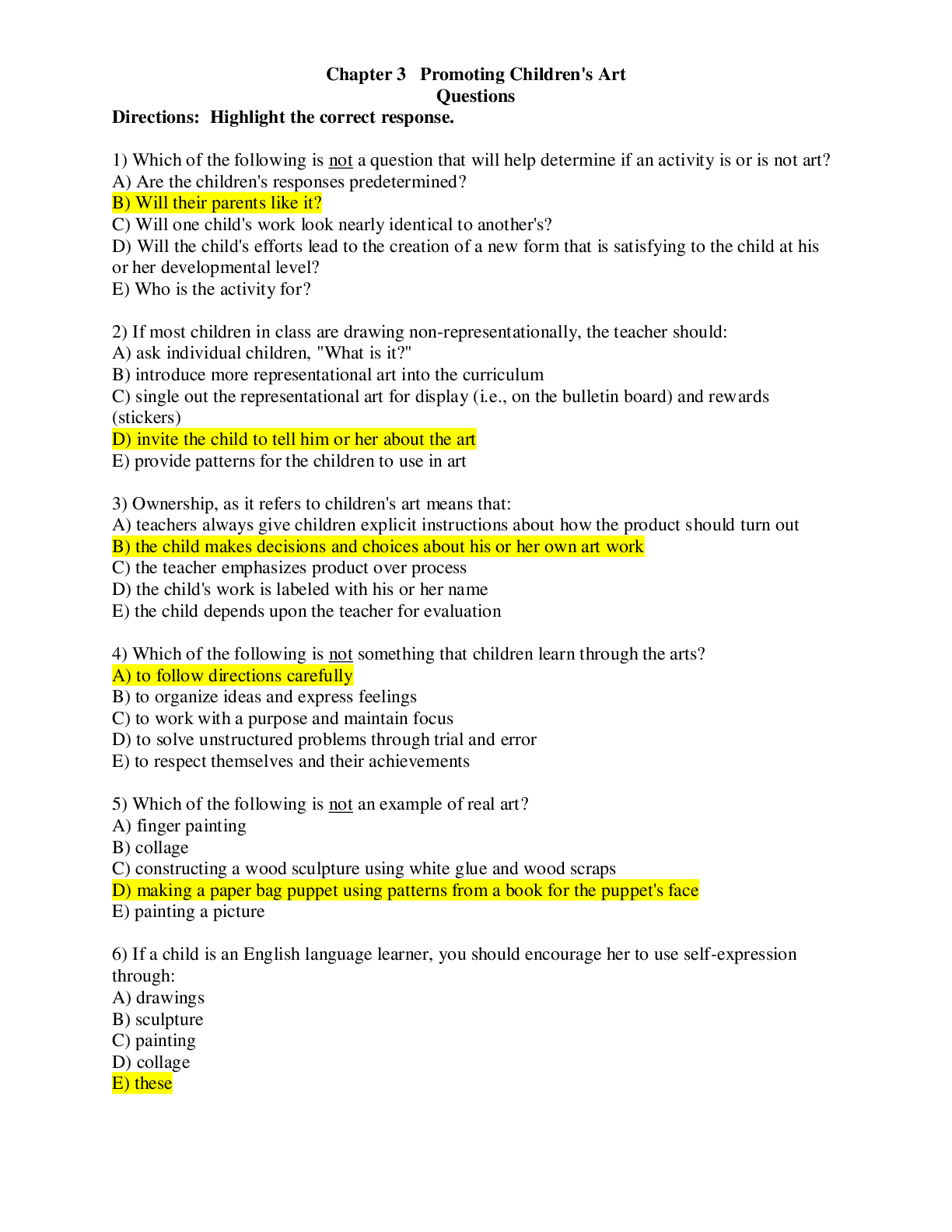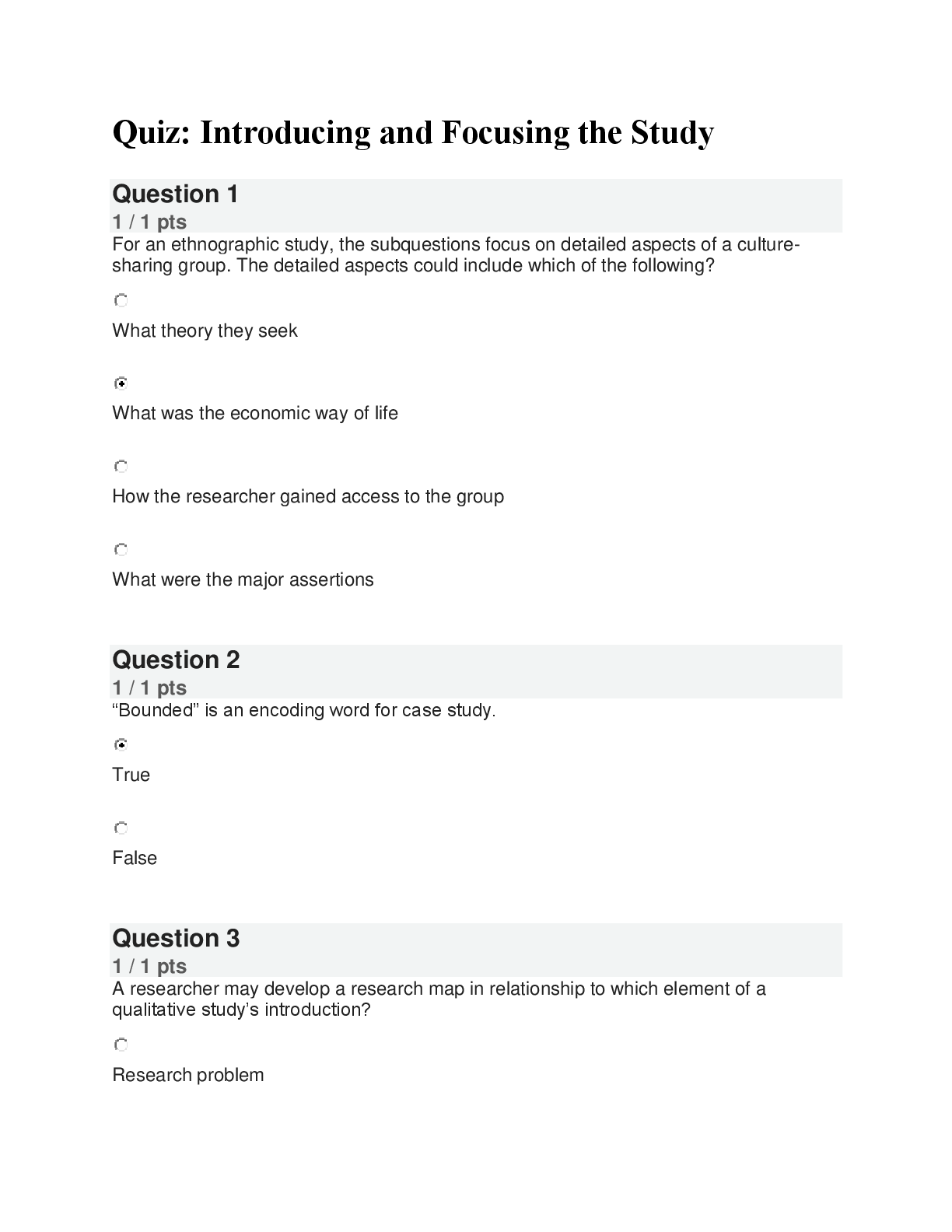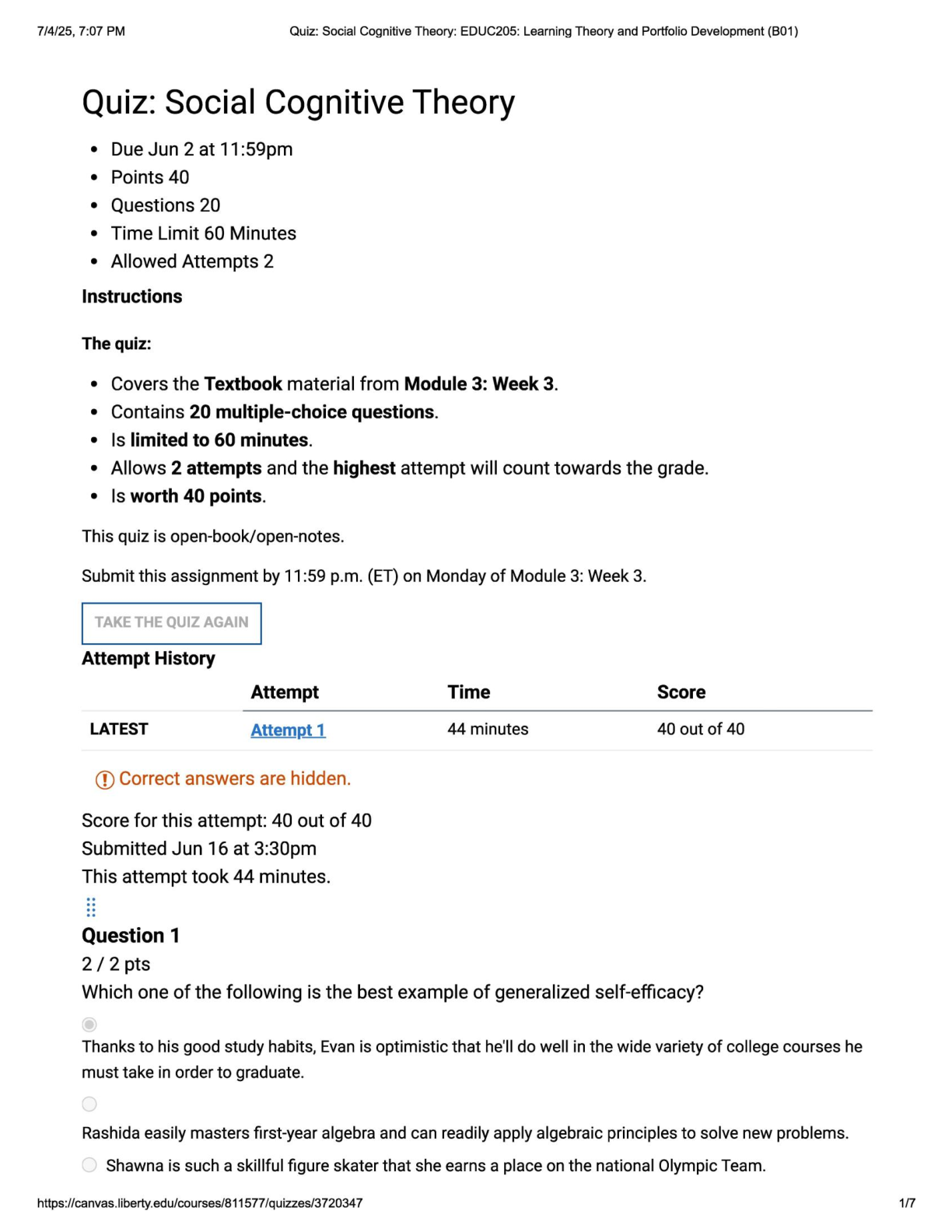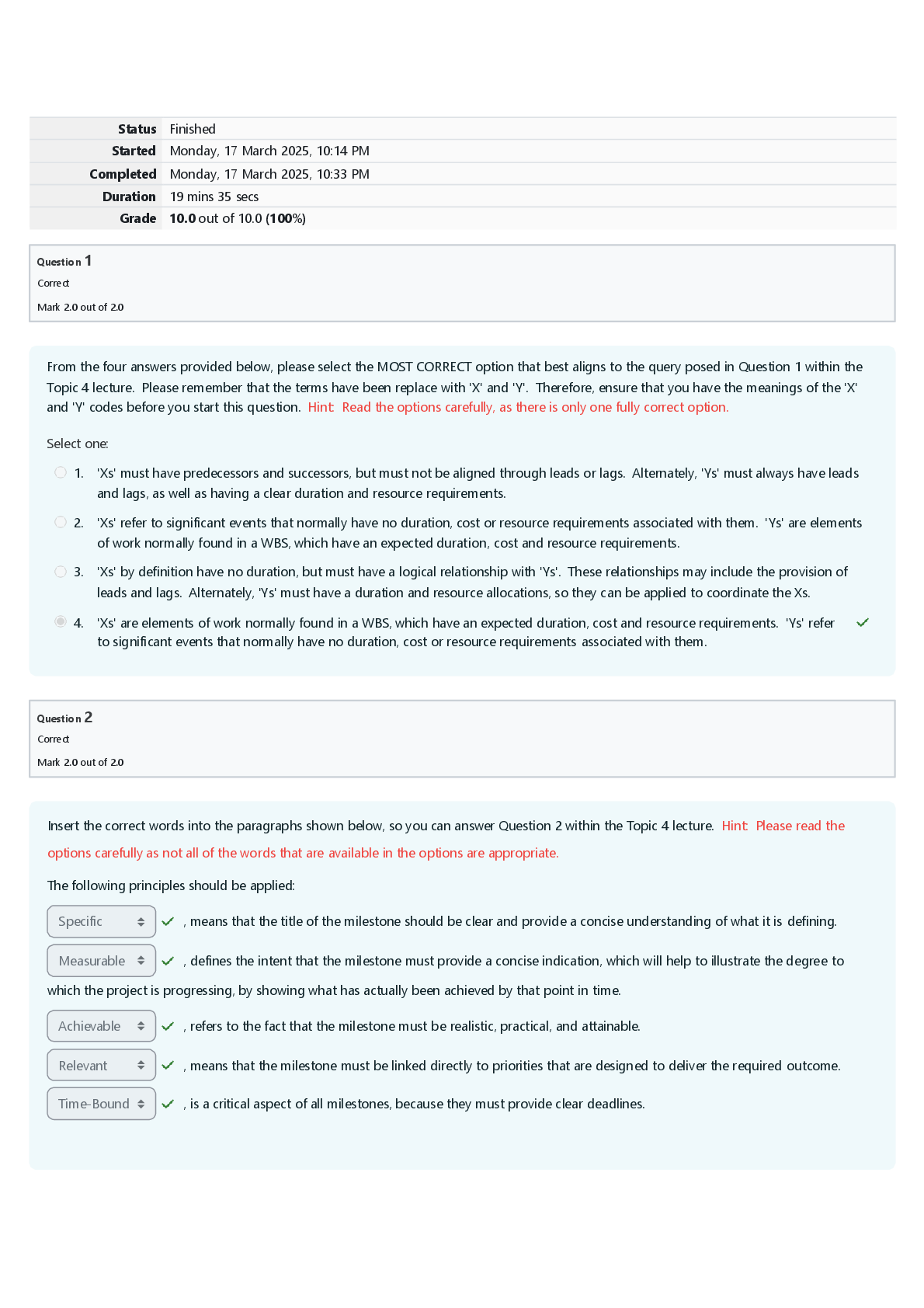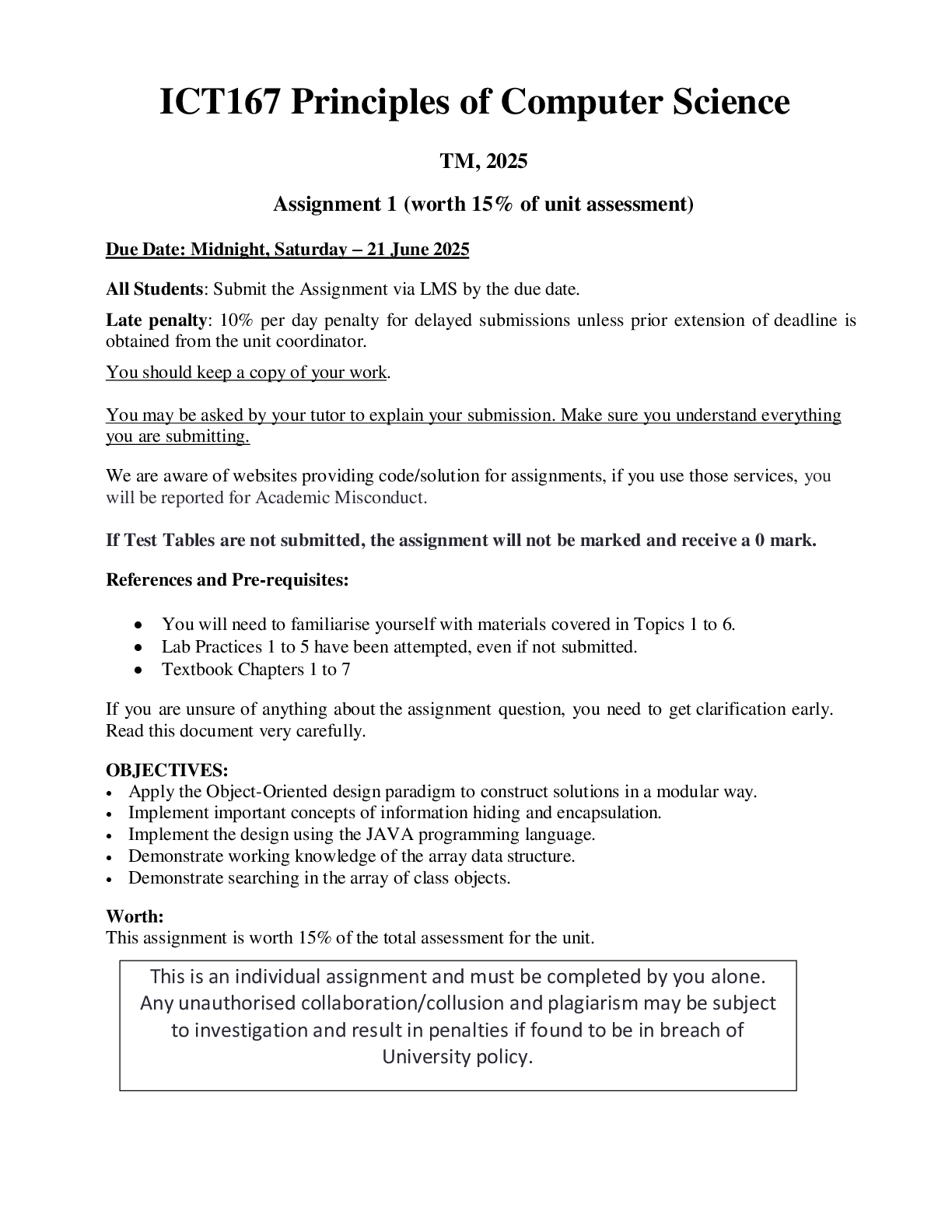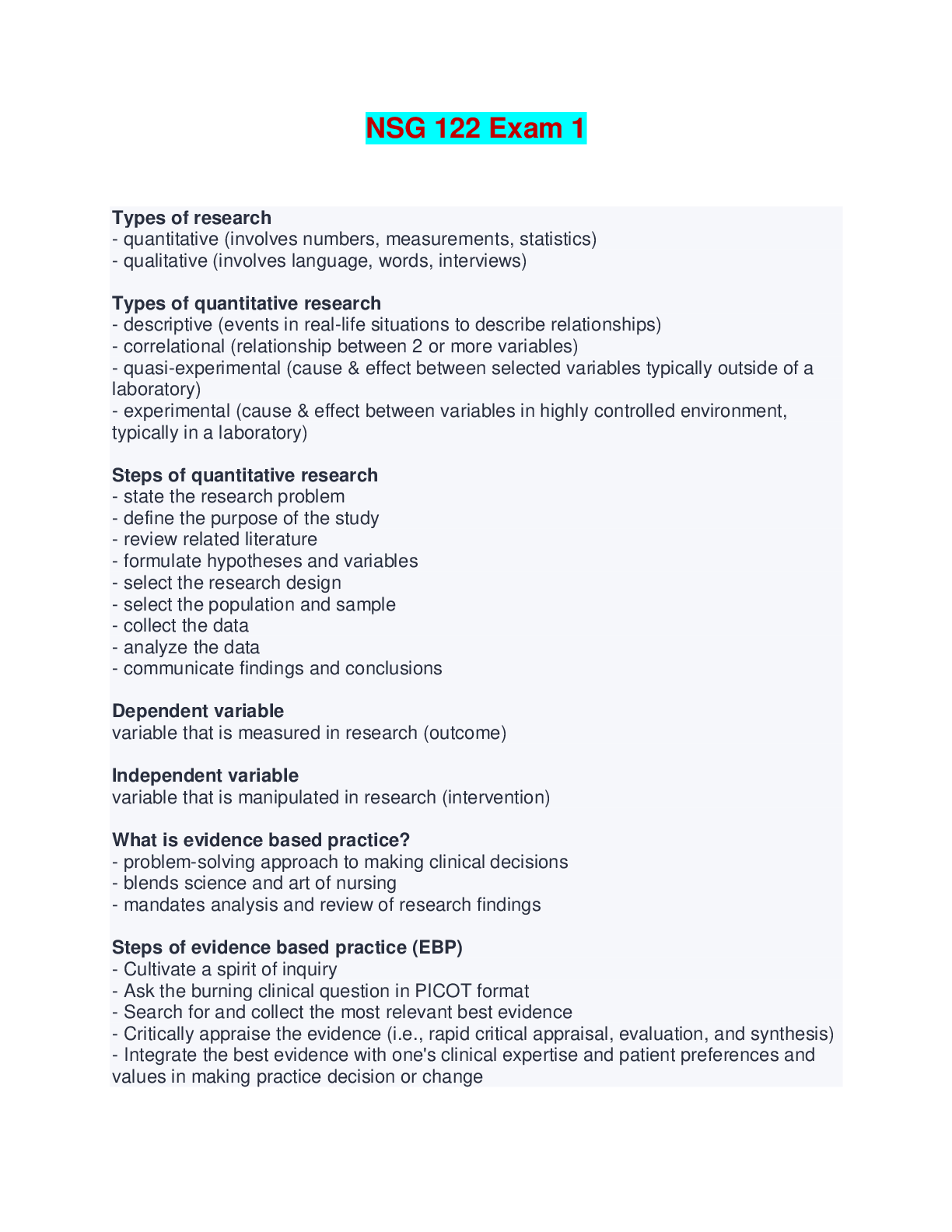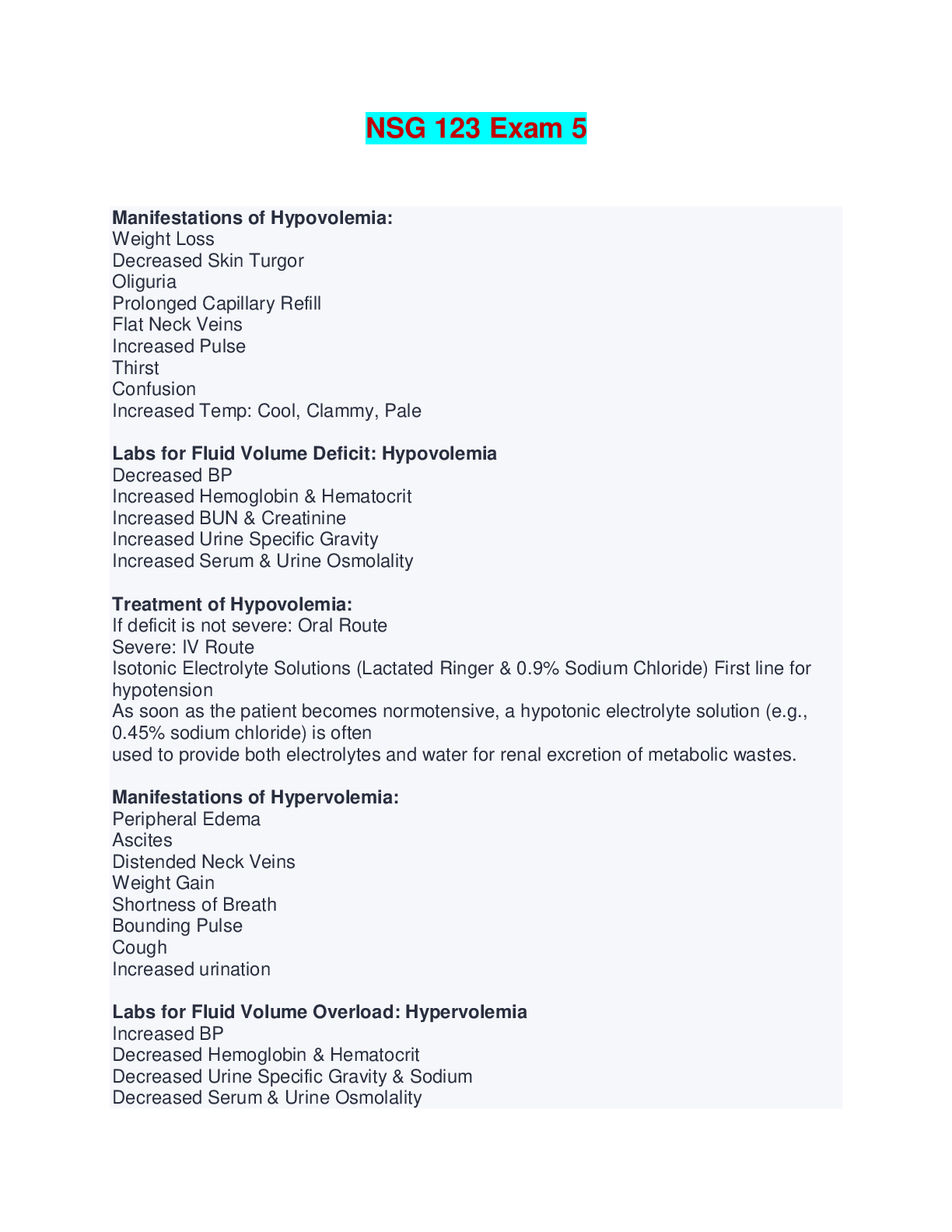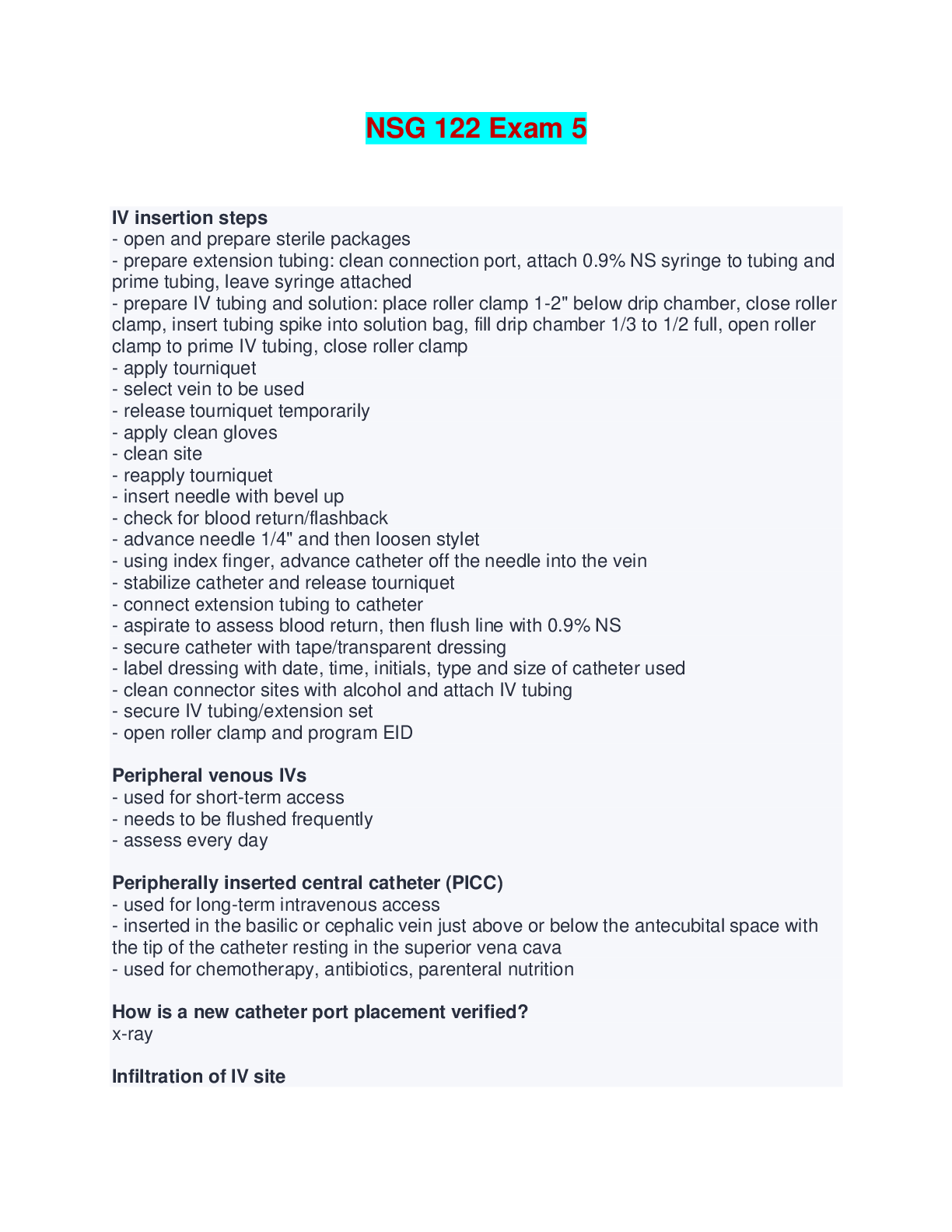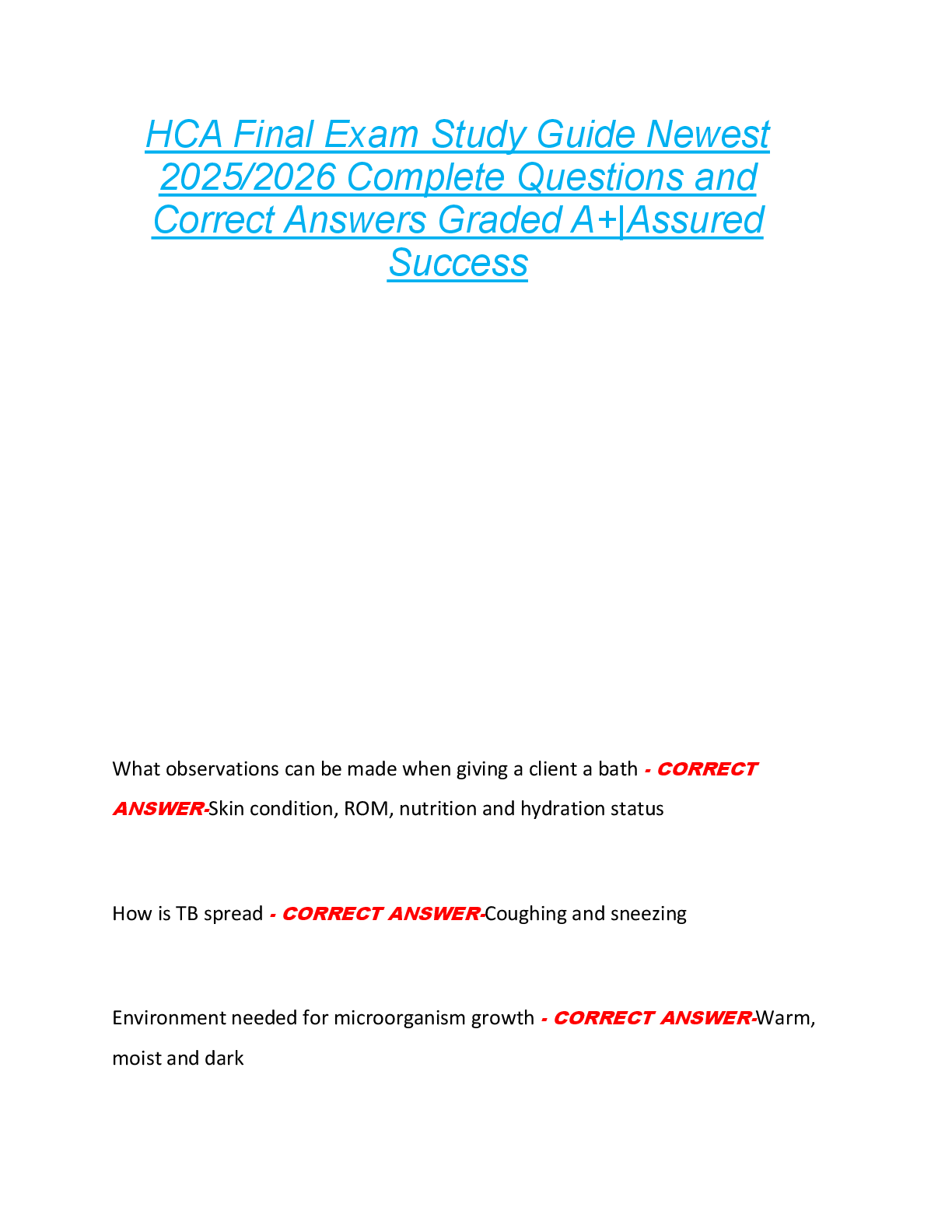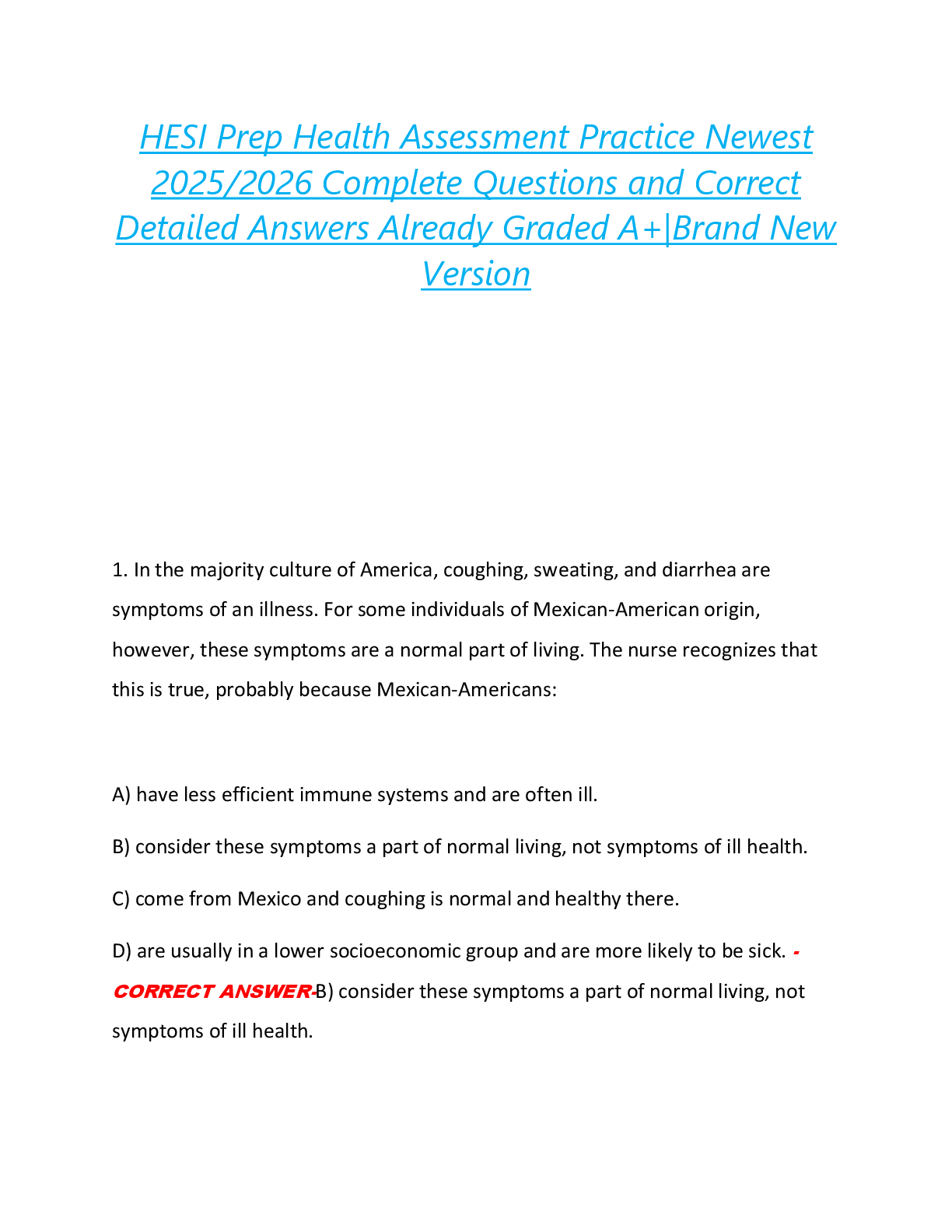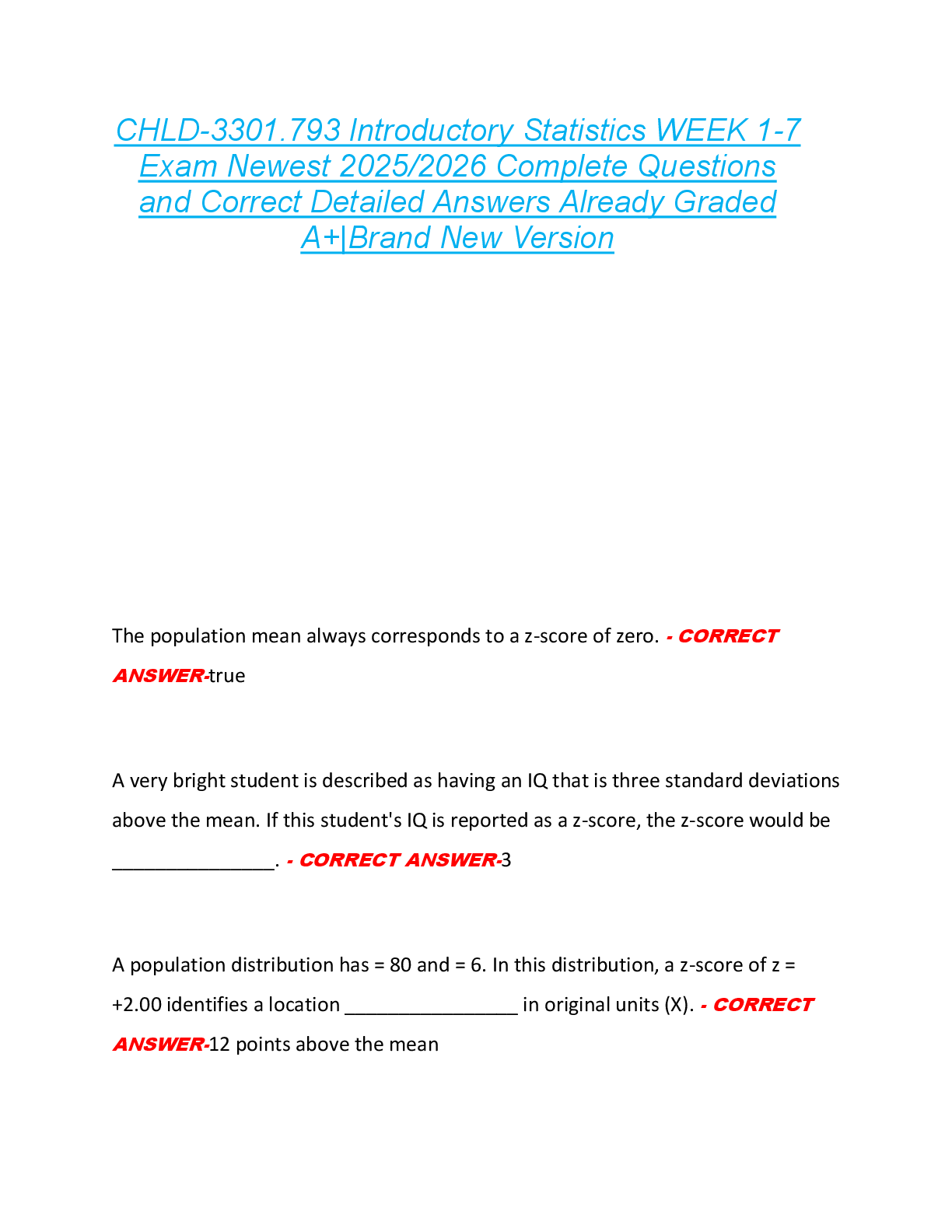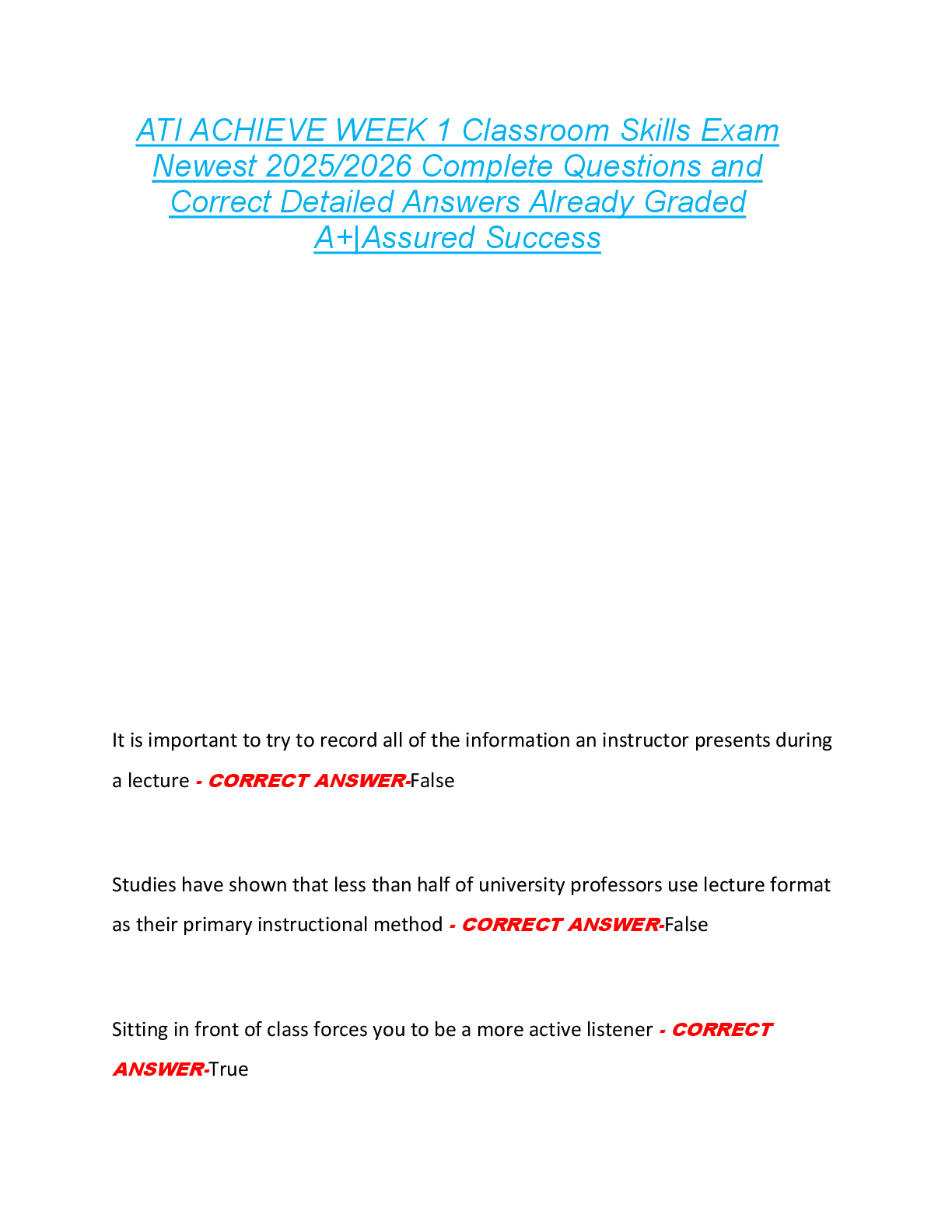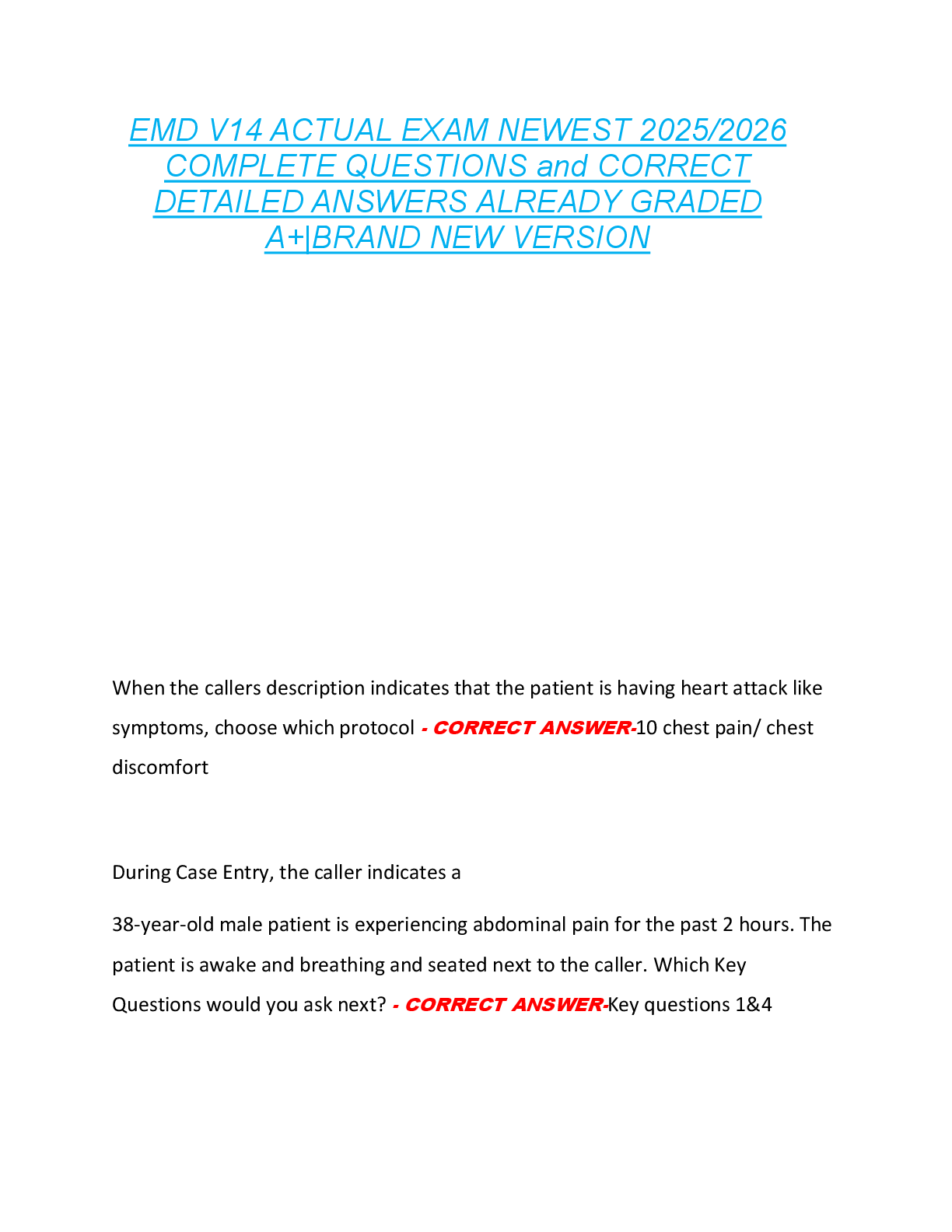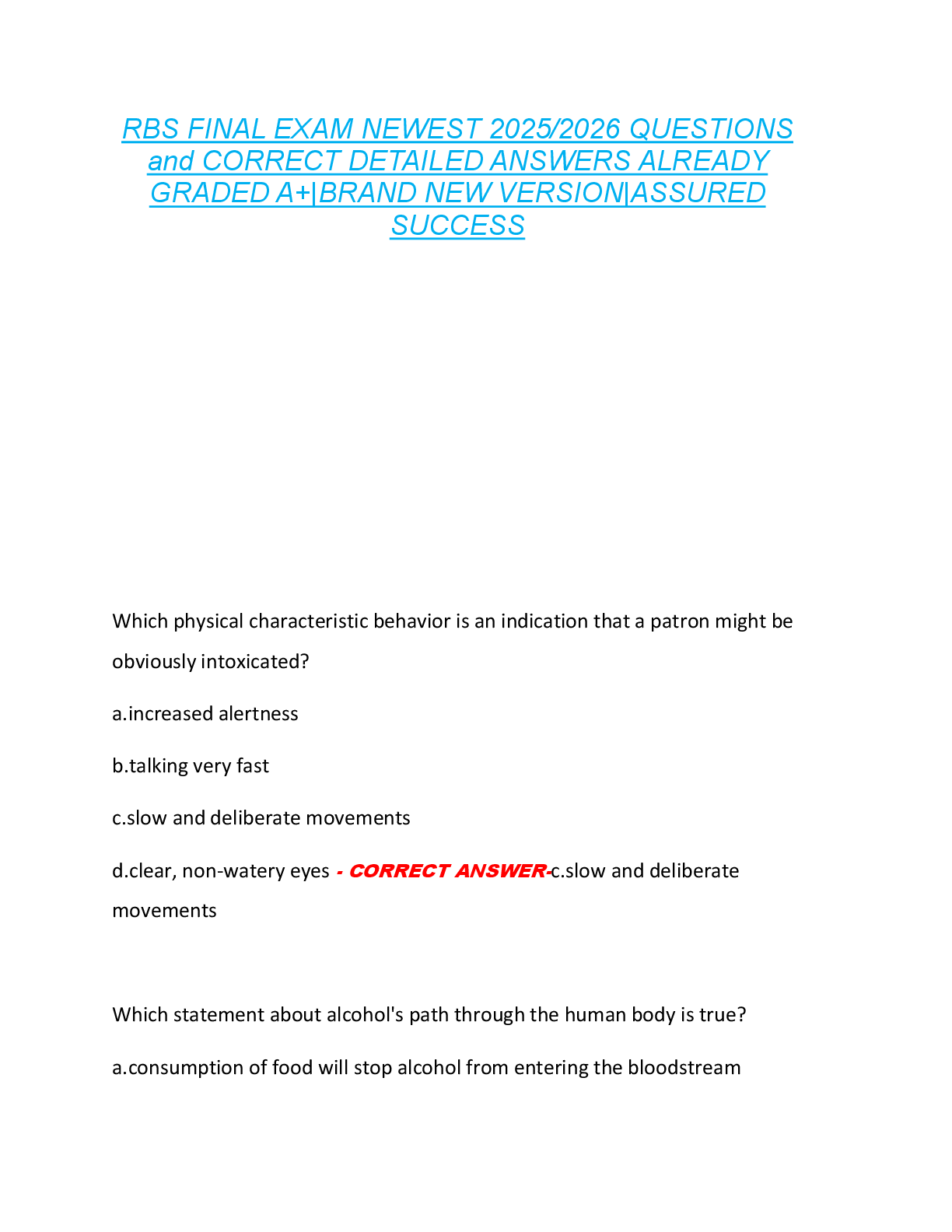EDCI 2271 Chapter 3 Promoting Children's Art - Questions and Answers (All Verified)
Document Content and Description Below
Chapter 3 Promoting Children's Art Questions and Answers Directions: Highlight the correct response. 1) Which of the following is not a question that will help determine if an activity is or is not ar
...
t? A) Are the children's responses predetermined? B) Will their parents like it? C) Will one child' s work look nearly identical to another's? D) Will the child's efforts lead to the creation of a new form that is satisfying to the child at his or her developmental level? E) Who is the activity for? 2) If most children in class are drawing non-representationally, the teacher should: A) ask individual children, "What is it?" B) introduce more representational art into the curriculum C) single out the representational art for display (i.e., on the bulletin board) and rewards (stickers) D) invite the child to tell him or her about the art E) provide patterns for the children to use in art 3) Ownership, as it refers to children's art means that: A) teachers always give children explicit instructions about how the product should turn out B) the child makes decisions and choices about his or her own art work C) the teacher emphasizes product over process D) the child's work is labeled with his or her name E) the child depends upon the teacher for evaluation 4) Which of the following is not something that children learn through the arts? A) to follow directions carefully B) to organize ideas and express feelings C) to work with a purpose and maintain focus D) to solve unstructured problems through trial and error E) to respect themselves and their achievements 5) Which of the following is not an example of real art? A) finger painting B) collage C) constructing a wood sculpture using white glue and wood scraps D) making a paper bag puppet using patterns from a book for the puppet's face E) painting a picture 6) If a child is an English language learner, you should encourage her to use self-expression through: A) drawings B) sculpture C) painting D) collage E) these 7) Which of the following is not a practice that will promote safe art instruction? A) proper ventilation B) prominent placement of the Poison Control Center number C) locked storage of materials that require teacher supervision D) use of inexpensive, imported products E) access to complete information about allergies, respiratory problems, etc. 8) Which of the following is an effective response to children's art? A) present one model B) intervene when children seem stalled or frustrated C) emphasize technical ability D) recognize that the child tried hard and accept slapdash work 9) Which of the following is an appropriate way to develop children's vocabulary about art? A) insisting that children use the correct terms when discussing art B) introducing the vocabulary in context C) rewarding a memorization of word lists D) avoiding the use of accurate vocabulary that may be too hard for the children E) having older children visit the classroom to drill the children on new words 10) Some of the things that children should do in an art program include: A) examining intensively both natural and man-made objects from many sources B) experimenting in-depth with art materials and processes to determine effectiveness in creating new forms C) working with tools appropriate to the child's abilities and developing skills needed for satisfying aesthetic expression D) organizing, evaluating, and reorganizing works-in-progress to gain an understanding of line, form, color, and texture in space E) all of these 11) When discussing art with young children, use art that: A) shows human figures B) is unfamiliar C) intrigues the children D) is abstract E) requires the use of art vocabulary 12) It is important for teachers to make art activities accessible to young children with special needs. An adaptation for a child with learning disabilities or attentional difficulties includes all of the following except: A) establish and maintain routines B) offer a choice of media for exploring techniques or skills C) help the child deal with frustration productively D) have the child work with a partner and allow the partner to complete the work 13) Some indicators of poor quality in an art program are: A) children use art materials and request specific materials B) children are unwilling to accept new challenges in art C) children pursue art activities during free time at home and at school D) children express positive attitudes toward art and artistic abilities during class discussions 14) Which of the following is not a recommended practice in the teaching of art? A) emphasizing process as well as product B) valuing children's originality C) allowing children to retain ownership of their artwork D) requiring conformity E) demonstrating the appropriate use of materials 15) Which of the following is not a guideline for displaying children's art? A) placing the work at an adults' eye level B) rotating art regularly C) utilizing a variety of spaces—not just walls or bulletin boards D) highlighting children's work in special ways; with frames, on mobiles, in collages. 16) Teaching through the arts is: A) creating art projects about a specific idea B) guiding children to develop artistic skills C) acquiring knowledge about the arts D) using creative and artistic approaches to teach all curricula E) combining the arts with other subjects 17) Early artistic development in children: A) explores media through all senses B) experiments with color, line, shape, and arrangement C) includes random marks and scribbles that become more controlled and more deliberate with experience. D) all of the above 18) Young gifted children's art work may include all of the following except: A) many details B) display types of perception C) unrealistic portrayals D) display exceptional sensitivity 19) Art among young (preschool) children usually is classified as: A) Emerging Representational B) Nonrepresentational C) Representational D) "Feeling Art" E) Explorational 20) Which of the following influence(s) young children's artistic development? A) Family support B) Mental capacity C) Cultural Opportunities D) Access to art materials E) All of the above 21) Representational art: A) Combines shapes to make mandalas B) Shows planning and inclusion of details C) Names scribbles D) Makes scribbles on top of scribbles E) Shows a figure that "floats" on the page 22) Which of the following is an example of art for very young children? A) creating macaroni necklaces B) using finger paints to create pictures of their choice C) coloring pictures from coloring books D) making houses out of popsicle sticks E) painting with shaving cream 23) Decreases in funding have caused a school district to no longer offer art classes to first-grade children. What is one way that first-grade teachers can provide students art experiences under such circumstances? A) Allow children to make necklaces by coloring and stringing macaroni. B) Let children choose different materials to create pictures and projects. C) Purchase pre-packaged crafts for students to complete during free time. D) Distribute a variety of coloring pages to children throughout the day. 24) Cassidy, a fourth-grade student, indicates that her favorite subject at school is art. She often shares beautiful and unique creations with her teacher. Her teacher is surprised when Cassidy comments, "Do you think I'm wasting my time? My older sister told me I will never be an artist like my dad." How can the teacher respond to help Cassidy understand the importance of art? A) Affirm Cassidy's passion for art and suggest activities in the community that will allow her to pursue her interests and make a more informed decision. B) Caution her that very few people ever become artists and that she would be better off pursuing something more practical. C) Suggest that Cassidy look online for advice to future artists. D) Call her parents to report that Cassidy's sister has been criticizing her. 25) A task that children in a second-grade class are required to complete is to draw a picture based on a specific event from a story. How can the teacher convert this tired, old activity into one that affords more opportunities for creative self-expression? A) Require children to work with a partner or in a small group. B) Provide a teacher model for children to follow but otherwise leave the assignment as is because it is effective in assessing a child's reading comprehension. C) Require the class to produce a mural of the entire story. D) Allow children to represent any aspect of the story that they choose through whatever art medium they prefer—markers, paints, collage, sculpture, poster, electronic media, and so forth. 26) While discussing the pictures in a book, students ask their teacher many questions about the technique used to create such distinct pictures. Noticing the interest of the students, how can the teacher best address their interest in art? A) Suggest that they conduct research into the particular art technique, invite a local artist to demonstrate it, and let the children experiment with it. B) Answer all of the students' questions but refocus the discussion on story elements. C) Suggest that the students investigate the technique online and assign it as homework. D) Change the subject since the questions are irrelevant to the students' understanding of the story. 27) A student teacher is attempting to decide on an art project to use with her three- and four-year-olds as a follow up to a picture book. Which activity would be preferable, based on what you now know about children's art development? A) Have the students glue tissue paper on a cut out heart to represent the theme of the story: friendship. B) Give children cut-out patterns of the main story characters to decorate. C) Use buttons, yarn, felt, fabric, and paper scraps to create make-believe pets because the child in the story imagined this. D) Make copies of a mini book of the story for children to color and take home. 28) A fourth-grade teacher organized a series she called "Friday afternoons with an artist" by inviting well-known, local artists to visit the class and share their works with them. The artists included, for example, a commercial artist for the newspaper, a woman who designs clothing that is representative of different historical eras, a bluegrass trio that performs at community events, and a children's playground designer who was responsible for the new park. The principal asks her what she expects children to learn from this. What might be an appropriate answer? A) "It will help them to get in touch with their own creative side and become more free spirited." B) "Creativity is an important skill in today's society. The children are acquiring the knowledge, skills, dispositions, and feelings about their diverse community and ways to contribute to it through their original work." C) "I think that children need a break from academic tasks on Friday afternoons and so do I." D) "I enjoy the arts and I think it is important for children to learn this during their elementary school years." 29) Three year old J.C. proudly runs up to his teacher to show her his painting of a fire truck that consists of red splotches of paint. The painting does not "look like" a truck at all. Which of the following is the best way to respond? A) "This is pretty. What is it?" B) "Maybe when you are in kindergarten, you'll be able to really draw a fire truck." C) "Oooh, I see lots of red. Tell me more about what you painted." D) "Let's try this again so that it is good enough to put up on the bulletin board." 30) A class was painting pictures of the ocean and experimenting with mixing colors with a roller. One child in the class does not have the motor skills necessary to do this. What could the teacher do to include the child with special needs in the activity? A) Find a computer app that simulates the experience with mixing colors. B) Skip this project entirely. C) Do a teacher demonstration of mixing colors and using a roller but do not allow any of the children to actually do it. D) Wait until Alex leaves the room for his therapy and quickly have the other students try it. 31) When searching for art materials, one should seek materials that: A) are plentiful B) extend the experience of the children C) are easily accessible to the children D) are developmentally appropriate E) are high quality F) all of the above 32) How can teachers help develop children art vocabulary? A) Encourage children to discuss art in complicated art language. B) Introduce art vocabulary in context. C) Modeling appropriate and accurate vocabulary about art. D) B and C E) All of the above 33) Studying art and artifacts is appropriate for children with special needs because: A) Artifacts are imaginary objects and children can experience them on a creative level B) Artifacts are concrete objects and can be approached at many different levels C) Artifacts are readily available and easy to find D) Artifacts exist in many media to offer diverse experiences 34) When responding to children's artwork, teachers should: A) Emphasize feelings and responses B) Tell children what to do when they are stuck in their work C) Guide Children to do their best D) Recognize the product E) A and C Directions: Use the following choices to answer the items below. Put the correct letter on the line. 35) A. perceptual B. cognitive C. developmental D. graphic E. affected by the context and culture 1. ___B____ Art is related to the child's thinking processes. 2. ___A____ An artist needs to be keenly aware of sensory input. 3. If a child realizes that a drawing can express feelings in a concrete way, this illustrates the child's understanding of the ____D____ nature of art. 4. ___C____ A child's art changes as the child matures. 5. ___E____ A child’s art reflects the events and beliefs that she experiences daily. 6. ___C____ In terms of human figure drawings, toddlers usually scribble, threes usually name their scribbles, and preschoolers begin to produce "tadpole" people. 36) Match the items below with the appropriate answers that refer to influences on the child's artistic development. A. prior experiences B. cultural opportunities C. family discipline D. visual skills, mental capacity, and motor coordination E. all of these 1. ___A____ Refers to whether or not children have had access to art materials and experiences. 2. ___E____ The strengths, abilities, and adaptations that must be considered in order to provide authentic art activities for all children. 3. ___B____ Refers to children's opportunities to see various types of art in their environments and learn about art of different cultures. 4. ___C____ The effect of adults' acceptance or rejection of children's artistic efforts and pursuits. 37) Arrange the following skills in learning to cut with scissors from the least difficult to the most difficult. A. 1 -- least difficult B. 2 C. 3 D. 4 E. 5 -- most difficult 1. ___D____ Cutting out a simple shape on the lines. 2. ___A____ Tearing newspaper by hand. 3. ___B____ Cutting pieces of modeling dough rolled thin or tearing at the paper with scissors. 4. ___E___ Cutting out small interior spaces (such as the eye holes for a mask). 5. ___C____ Making simple cuts, such as paper fringe. 38) Arrange the steps in teaching children to use paints in the correct sequence, from most basic to most complex. A. first step B. second step C. third step D. fourth step 1. ___B____ Present the strategy of wiping each side of the brush on the rim of the paint container to avoid drips and grasping the brush with fingers (rather than fist) above the metal rim. 2. ___C____ Show children how to avoid smearing by letting one color dry before putting wet paint over or very close to it, how to use different size brushes for different purposes, and how to rinse brushes in cool water and store them with bristles up. 3. ___A____ Present the basic concepts of using protective clothing, putting the brush back in the same color, and cleaning up after painting. 4. ____D___ Teach children different brush strokes or how to sketch before painting. 39) Match the approximate age group to the most appropriate stage in the development of art skills. A. infants and toddlers B. preschoolers and kindergartners C. first graders D. second and third graders E. all of these 1. ____D___ Children seek to build competence by undertaking a wide variety of art activities, including completing multi-step group projects. 2. ____E___ Art activities are an essential part of the curriculum. 3. ____B___ Children begin to learn how to communicate through symbols, as control of drawing increases. 4. ____A___ Children communicate directly through body movements. Visual artworks are more of a happening than a means of communicating. 5. ____C___ Children become more competent as symbol makers, using new and more involved techniques. Directions: Type True or False for the questions below. 40) Art works need to be produced in a solitary fashion; otherwise children will copy the work of their peers. 41) Art offers a way of communicating and accepting other cultures by giving children insight into the history, values, and aesthetic sensibilities of themselves and others. 42) Children should not have access to art materials because they can be unsafe and messy. 43) If the teacher asks questions such as: "Look at the lines on your paper. On the ceiling. Can you find other lines? Thin lines? Thick lines?" that teacher is building children's conception of an artistic element. 44) If the teacher gives clear instructions such as "Everyone, look up here. Your rabbit should look exactly like mine when you are finished," that teacher's behavior reflects sound teaching practices. 45) Any sensory experience is an art experience. 46) If the teacher shows pictures of several sculptures, then asks, "Which one of these sculptures was made a long time ago? Why do you think so?" that teacher is encouraging children to think more deeply about works of art. 47) Teachers should model for children the importance of conserving materials and using only what is necessary. 48) If a teacher teaches children to share supplies, to respect the work of others, and to help clean up, that teacher is thwarting children's creativity. 49) When teachers are guiding an art activity for young children, it is not important to teach young children about the use and care of art supplies and equipment. 50) Children with physical disabilities cannot be expected to benefit from or participate in art activities. 51) Art can become a refuge for children with academic difficulties when competition is downplayed and they are allowed to pursue their interests at their own pace. 52) All art materials should be thoroughly tested by the manufacturers so that health and safety concerns are effectively eliminated and no further considerations need to be taken. 53) Art provides young children with an appropriate outlet to express strong emotions and feelings. 54) When the arts are combined appropriately with other subject areas, the integrated curriculum has personal relevance for students. 55) Growth in art is indicated by sequential stages of development that cannot be forced. 56) Within the Reggio Emilia approach to early childhood, children are viewed as passive seekers of knowledge. 57) Children should be taught the steps to cleaning up after using art supplies.
[Show More]
Last updated: 3 years ago
Preview 1 out of 9 pages
, Question Answers, Correct , Correct Answers.png)
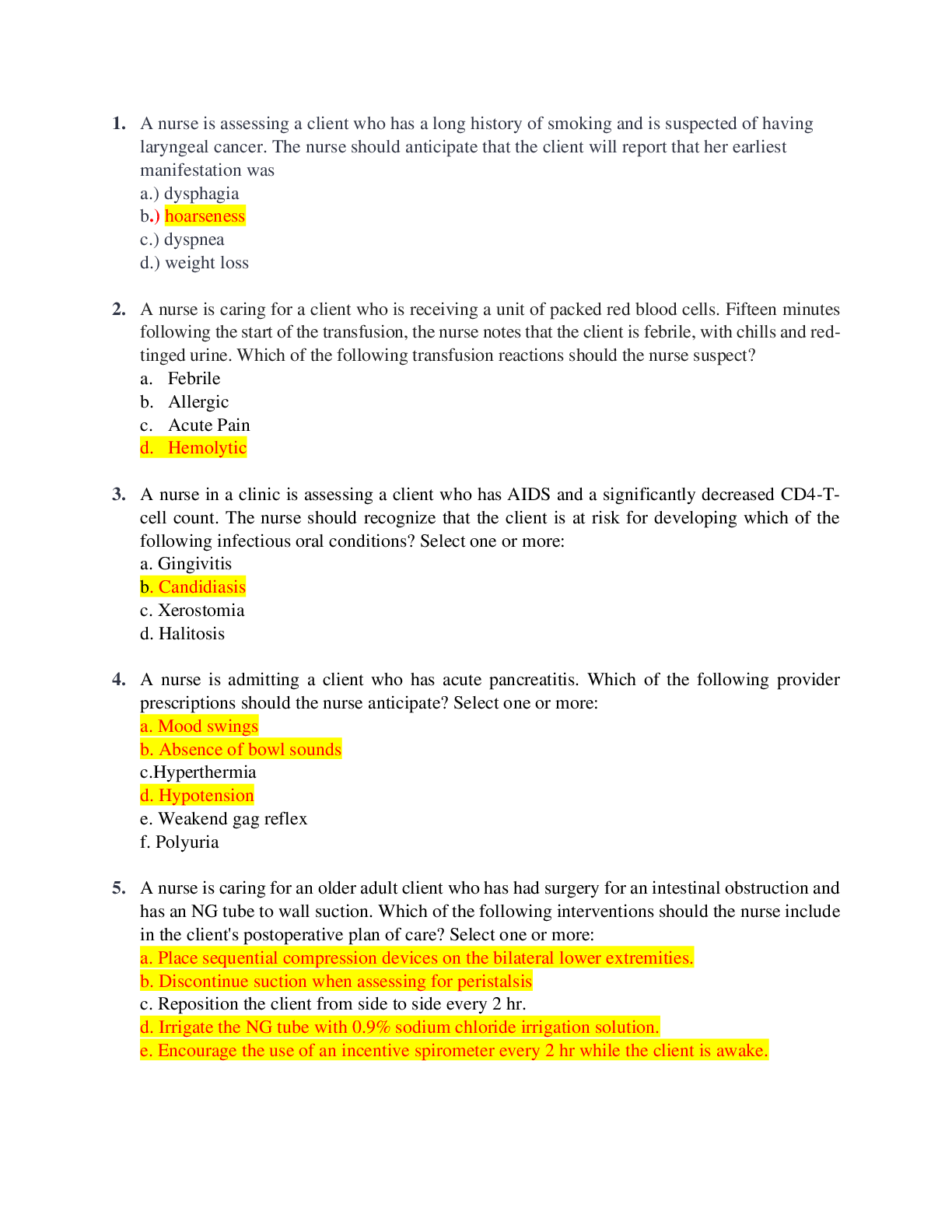

.png)

